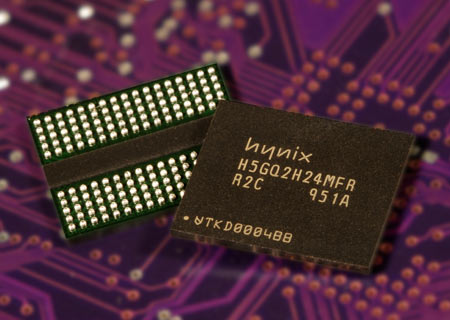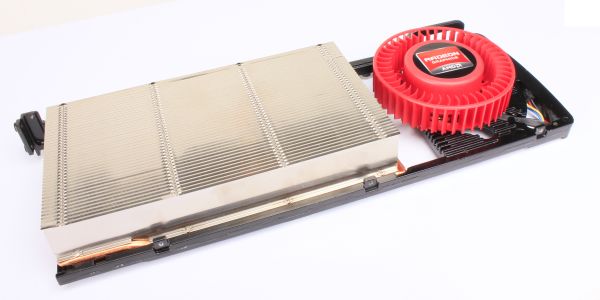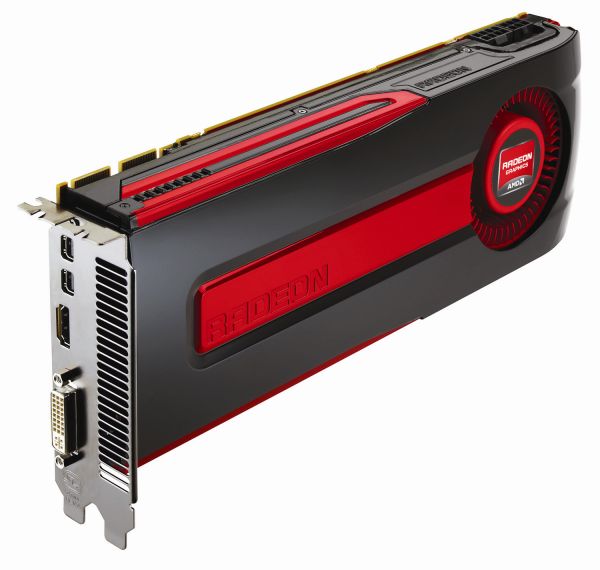AMD Radeon HD 7970 Review: 28nm And Graphics Core Next, Together As One
by Ryan Smith on December 22, 2011 12:00 AM EST- Posted in
- GPUs
- AMD
- Radeon
- ATI
- Radeon HD 7000
Meet the Radeon HD 7970
Now that we’ve had a chance to discuss the features and the architecture of GCN and Tahiti, we can finally get to the end result: the card. AMD’s first product in the Southern Islands family is the Radeon HD 7970, continuing AMD’s tradition of launching their fastest single-GPU first.
As we’ve already covered in our discussion on GCN/Tahiti’s architecture, Tahiti shares a lot of physical similarities with Cayman, and so then does the 7970 with the 6970. With the 7970 AMD has targeted a very similar power profile as the 6970, and while AMD has not published the typical board power of the 7970 we know the PowerTune limit is 250W, the same as with the 6970. As a result the 7970 is at least superficially designed to work in the same environments/constraints as the 6970.
With that said, AMD has not sat idle when it comes to the design of the card – this isn’t just a Tahiti GPU put in a 6970 shell. Livery changes aside it’s clear that the 7970 is a distinct card just from looking at it. AMD’s ill-fated boxy design for their cards is gone; the removable plastic shroud is now once again a rounded design similar to the 5800 series, and this time AMD takes it a step further by slightly rounding off the rear of the card for airflow purposes. Furthermore the shroud is now made of a very hard, very shiny plastic, versus the soft plastic used in past cards.
But the bigger change is on the back of the card, where AMD has completely done away with the backplate. First used in the 5800, backplates help to protect the card from users (and users from the sharp bits of the card), but the tradeoff was that the backplate occupied 2.7mm of space. What’s the significance of 2.7mm? When you’re trying to put these cards adjactent to each other for CrossFire, it’s everything as we have found out.
The boxy design coupled with the backplate meant that the 6900 series used virtually every last millimeter of space they were allowed under the PCIe specification; the cards were so wide that when adjacent it was easy for a card to shift and block the airflow of the neighboring card. The backplate contributed to this problem by consuming 2.7mm of space that could otherwise be used to channel airflow, and as a result it’s gone. AMD’s design doesn’t have the overt wedge that NVIDIA’s does to allow airflow, but it should be enough to keep the cards well enough separated to allow them to breathe when they’re closely together for CrossFire.
Overall the card is 10.5” going by the PCB, but AMD has a metal reinforcement ring/plate running along the entire card that sticks out the rear. After accounting for this plate the total length of the card is just shy of 11”, making the card roughly half an inch longer than the 6970 and 5870. The difference is not huge, but it will make the 7970 ever so slightly harder to fit than the 6970 in space-constrained cases.
Moving on, while AMD has made some changes to the shrouding to improve cooling, they haven’t stopped there. The blower has also been tweaked slightly compared to what we’ve seen on the 6970. The 7970’s blower is a bit larger (~75mm) and the fins are slightly larger to make use of that space. Overall this should improve the amount of air moved at speeds similar to the blower on the 6970, though AMD didn’t provide any numbers.
Meanwhile the heatsink is very similar to the 6970’s. As with the 6970 an aluminum heatsink sits on top of a vapor chamber cooler that draws heat from the GPU and other components towards the heatsink. Other than being a bit larger than the 6970 the biggest difference is that AMD is now using the same higher performance phase-change TIM that they used on the 6990, which also means that AMD is highly recommending that the 7970 not be disassembled as the TIM won’t operate nearly as well once it’s been separated. Furthermore as we found out the specific TIM AMD is using is screen printed onto the GPU, so reapplying a new TIM in the same manner is virtually impossible.
Finally, it’s once we move towards the front that we see the biggest change in the name of cooling: AMD has once again moved back to a full slot exhaust vent. As you may recall, starting with the 5800 series AMD moved to a half slot vent configuration so that they could use the other half of the second slot to fit a second DVI port along with their DisplayPort and HDMI ports. The half slot vent did not prove to be a huge problem for the 5800 or 6900 series but it still placed some limits on AMD’s ability to cool their cards and made the process a bit noisier. As the second DVI port has become redundant (more on that later), AMD has opted to get rid of it and go back to using the whole slot for cooling. One way or another though this was probably necessary – looking at our data the 7970 is a bit more power hungry than the 6970 even if the specifications are similar, and as a result AMD needs better cooling to keep parity with the 6970.
Moving on, tweakers will be happy to see that the dual BIOS feature first introduced on the 6900 series is back. The 7970 will feature the same dual BIOS configuration, with a locked factory BIOS (2), and a rewritable BIOS (1) for other uses. As with the 6900 series this is primarily to allow failsafe BIOS flashing, but the implications for GPU unlocking lower tier cards are clear. In fact we’re surprised that AMD included the switch given how rampant 6950 unlocking was, as while it was good PR it must have been bad for their 6970 sales.
Next to the BIOS switch we will find the PCIe power sockets, which given the 250W PowerTune limit of the card mean we’re looking at the same 6+8pin configuration as the 6970. Enthusiasts who caught on to the fact that AMD had to shave some PCIe sockets on the 6900 series should note that the sockets are untouched on the 7970, as the blower now sits above the PCIe sockets. Elsewhere at the front end of the card we’ll find the two CrossFire connectors, and as always when it comes to their high-end cards AMD is supporting up to 3-way CF with the 7970.
Back to the front of the card we can see AMD’s new Southern Islands port configuration. As you may recall from the 6000 series, with the 6000 series AMD moved from being able to drive 2 dual-link DVI ports (2 sets of paired TMDS transmitters) to being able to drive 1 dual-link DVI port + 1 single-link DVI port, as they removed the 4th TMDS transmitter. Furthermore as AMD has only been able to drive 2 TMDS-type ports at once, the 2nd DVI port was largely redundant as everything it could do the HDMI port could do with a mechanical adaptor.
So for Southern Islands AMD has taken this to its logical conclusion and cut out the 2nd DVI port entirely. There is now a single DL-DVI port, along with an HDMI port and 2 miniDP ports all along a single slot. The 7970 still has the internal logic to drive the same monitor configurations as the 6970, but anyone using the SL-DVI port will now be fed by the HDMI port. In order to make this transition easier on buyers, AMD will be requiring that partners ship both an HDMI to SL-DVI adaptor and an active miniDP to SL-DVI adaptor with their 7970s, so 7970 users will be able to drive up to 3 DVI monitors out of the box, which is actually better than what the 6970 could do. Of course we expect that this will be a limited time offer; once AMD’s partners start putting together cheaper cards later in the 7970’s life, the mDP to SL-DVI adaptor will be the first thing to go.
On that note, for anyone who is curious about idle clockspeeds and power consumption with multiple monitors, it has not changed relative to the 6970. When using a TMDS-type monitor along with any other monitor, AMD has to raise their idle clockspeeds from 350MHz core and 600Mhz memory to 350MHz core and the full 5.5GHz speed for memory, with the power penalty for that being around 30W. Matched timing monitors used exclusively over DisplayPort will continue to be the only way to be able to use multiple monitors without incurring an idle penalty.
Next on the docket we wanted to quickly touch on the subject of RAM. As with their past cards AMD has outfitted the 7970 with RAM rated beyond their memory speed requirements, in this case the 7970 is outfitted with 6GHz modules even though it only needs to operate at 5.5GHz. We haven’t been able to take the card apart so we haven’t seen whose modules AMD is using, but we strongly suspect they’re the same 2Gb Hynix modules the reference 6970 used.
With the move to a 384bit bus AMD has increased the chip count from 8 to 12, and the total RAM size from 2GB to 3GB. As games are only now starting to effectively use more than 1GB of RAM this should offer plenty of headroom for future games, above and beyond even their existing 2GB cards.
At the same time with the move to a 384bit bus this has raised the question of where AMD goes from here. It’s well published that GDDR5 is an intricate memory technology to work with, with the memory bus being the hardest part. To run a 384bit bus at 5.5GHz is quite the accomplishment (NVIDIA didn’t get nearly that high with Fermi), but it also means that we’re near the end of the road for GDDR5. While GDDR5 is rated for up to 7GHz in the real world buses will never be able to scale quite that well and the required memory voltages are on the high side. Meanwhile a 512bit GDDR5 bus is possible but would be even more expensive and difficult than a 384bit bus, and it’s safe to say that’s not the preferred route.

So what comes after GDDR5? At this point AMD tells us that they’re looking at a few different things, but of course it’s far too early to discuss anything in detail. The JEDEC has not passed anything such as a GDDR6 standard, though we expect whatever technology AMD will eventually use will come out of the JEDEC. But if nothing else at this point it’s safe to assume that by the time we’re on 20nm GPUs we won’t be using GDDR5.
Finally, while we haven’t had a chance to tinker with overclocking due to our limited time with the 7970, but AMD is telling us that the 7970 is going to be good overclocker. Most cards should be able to hit 1GHz or higher on the core clock and 6GHz or higher on the memory clock with little effort even with the reference cooler, but the tradeoff will of course be in power consumption and noise, as you’ll need to increase the PowerTune limits to make those overclocks matter.




















292 Comments
View All Comments
Scali - Monday, December 26, 2011 - link
Lol, how's that, when I'm the one saying that AMD's cards are the best performers in Crysis 2?I'm neutral, a concept that is obviously alien to you. Idiots...
Scali - Monday, December 26, 2011 - link
Heck, I'm also the guy who made Endless City run on non-nVidia cards. How does that make me an nVidia fanboy?CeriseCogburn - Thursday, March 8, 2012 - link
That's sad when an nvidia fanboy has to help all the amd fannies with software coding so they can run a benchmark, then after all that work to help the underprivileged, nothing but attacks after the facts... finally silence them.It's really sad when the truth is so far from the pop culture mind that actually speaking it is nearly forbidden.
Thank you for helping them with the benchmark. Continue to be kind in such ways to the sour whining and disgruntled, as it only helped prove how pathetic amd dx11 was...
james007 - Friday, December 30, 2011 - link
This sounded like such an awesome card and I was psyched to get it the moment it comes out -- until reading the part about dropping the 2nd DVI port. A DisplayPort-to-SLDVI doesn't do it, for me, because my desktop has to drive two 30" displays. In fact, I would love to be able to drive a third display so I can have a touch-screen also. My current (previous-generation) VDC does drive both displays just fine.This does not seem like such an infrequent requirement, especially for high-end users. Why would they drop the ability to drive the 2nd display? !!!
Argh!
The_Countess666 - Saturday, December 31, 2011 - link
not trying to sell you anything but, HDMI to dual-link dvi does exist (see link, or google yourself for other shops).http://sewelldirect.com/hdmi-to-dvi-dual-link-cabl...
and these cards do have 1 HDMI-out so that should work for you.
Penti - Wednesday, January 4, 2012 - link
It's the IHV that makes those decisions any way, just because it's not on a reference card doesn't mean they won't show up or that you can't build a card with it. But the HDMI supports more then 1920x1200 finally on this card any how. I guess they could deliver a card with the old type of DVI>HDMI adapters. Obviously opting for HDMI and multidisplaycapable displayport 1.2 makes more sense though. It's been around for years now.Penti - Wednesday, January 4, 2012 - link
Just make sure you actually has the number of connections you need when buying the card, many 7970 bords only appear to support single-link DVI on the DVI-connector.poordirtfarmer2 - Wednesday, January 4, 2012 - link
Enjoyed the article.So this new 79XX architecture is about a GPU architecture that’s also good for “compute work”. The reference to NVIDIA ‘s professional video cards (Quadro ; Telsa), implies to me that this might mean video cards viable for use both in gaming and in engineering / video work stations.
I’m not a pro, but do a lot of video editing, rendering and encoding. I’ve avoided dedicating a machine with an expensive special purpose QUADRO video card. Am I reading the wrong thing into this review, or might the new 79XX and the right driver give folks like me the best of both worlds?
radojko - Thursday, January 5, 2012 - link
UVD 3 in NextGen is a disappointing. Nvidia is two generation in front with PureVideo HD 5.psiboy - Monday, January 9, 2012 - link
Well Mr Ryan Smith I must ask why the omission of 1920 x 1080 in al lbenchmarks... given that almost every new monitor for quite some time has been natively 1920 x 1080... what is it with you guys and Tom's lately.. you both seem to have been ignoring the reality of what most of your readers are using!